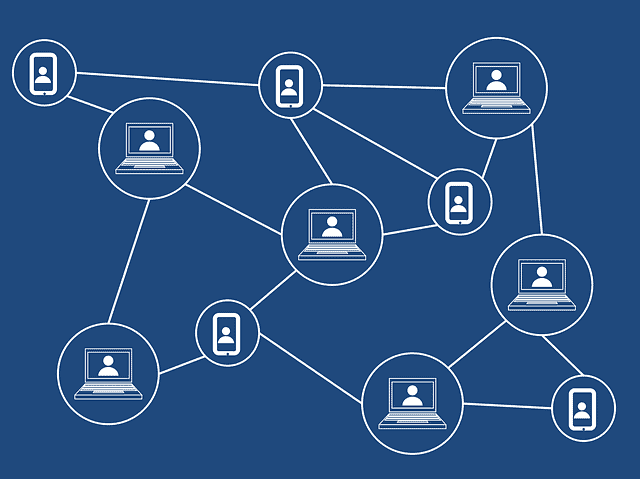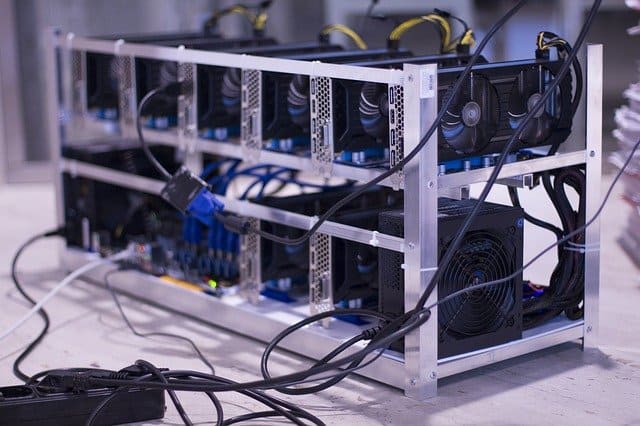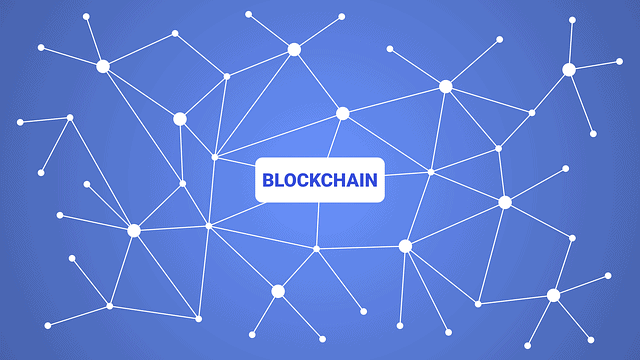What is blockchain?
Blockchain, you may have heard of it. Alongside the advent of the internet, blockchain is one of the greatest inventions of all time. But what is blockchain exactly? In this article we will explain what the blockchain is and what you can expect from it!
What is blockchain?
Blockchain can best be described as a new, digital system that can be used to record data. The blockchain system is a network of participants who control each other. There is no central party or intermediary in this network. There are two types of networks: Central networks and decentralized networks. Below is a simple example of a central network:
Imagine this: Jan wants to transfer $50 to his girlfriend Lisa and does this via his bank. The bank is in this example the central party and checks the account of Jan (is there enough money in the account?), then the bank debits the amount and credits it to the account of his girlfriend Lisa. Jan and Lisa trust the central party (the bank) to transfer the $50 and record the transaction.
A network without a central party is also called a peer-to-peer or a decentralized network. In such a decentralized network, everyone controls each other and is responsible for transactions in the network. In a decentralized network, there is no use of a central party such as a bank. The fact that all participants in the network register and approve a transaction makes the blockchain network unique and powerful. Below you can find a clear example of a decentralized network:
Jan wants to transfer $50 to his girlfriend Lisa. This request is sent to the network so that all the other people in the decentralized network can check whether Jan really has $50 to spend. Once all participants in the network have checked whether Jan has $50 to spend, the transaction is approved and can take place.
How does blockchain work?
Blockchain is therefore a decentralized network. At least three participants are always needed to carry out checks and keep the blockchain network secure. The verification of transfers is the most important task in the blockchain network. But how does a blockchain network work exactly? We will explain this to you with an example:
Imagine this: Jan, Lisa, Piet and Klaas live together in a house. Unfortunately, Piet leaves the house and a room becomes vacant. Using a blockchain, the agreements and payment obligations can easily be transferred to the new occupant. In addition, none of the residents are liable if the new resident is unable or unwilling to pay the rent on time.
Other data can also be recorded in the blockchain. Money can be released after all errands in the house have been performed and this has been checked by the participants in the blockchain. The blockchain can be used for various purposes, from transferring a certain amount of money to recording personal data.
Nodes, block & chain
As you just read, a blockchain network is a digital decentralized network or peer-to-peer network of people who are all linked together. To put it easily, a person in a blockchain network has a notebook and a map. Later in this article I will clarify the meaning of this ‘notebook’ and the ‘map’. Back to the example:
Our blockchain network consists of 4 people. Jan, Lisa, Piet and Klaas. Jan wants to transfer $100 to Peter. Then Jan tells everyone that he wants to transfer $100 to Peter. First, everyone checks whether Jan has enough money to transfer $100 to Piet. Is everyone in agreement? Then permission is given to transfer the $100. After that, everyone in the network writes down the transaction in his/her ‘notebook’.
Has everyone in the network noted the transaction in the notebook? Then the next transfer can already take place. This process continues until a page in the notebook is full. This page is then stored in the “folder”. Let us now deal with the technical terms of the blockchain.
In blockchain jargon, our ‘map’ is called a block. Such a block contains a lot of data. The first block in the chain (hence the name blockchain, chain=chain) is called the genesis block.
Jan, Lisa, Piet and Klaas are called nodes in official blockchain terms. These people (actually the people’s computers), check and verify all transfers using algorithms. All data is checked and registered and eventually ends up in the block.

Blockchain security
You might be wondering what happens when the notebook is completely full. The transfer of data or money within the blockchain network can go on for a very long time. This process of checking and consenting continues until one page of our proverbial notebook is full. Then this page is stored in the block and the next page can be used. This process takes forever.
As soon as a page of the notebook is full, it is safely stored in the block and the block is put in a chain. The pages are secured with a specific key that everyone in the network agrees to. This key, in combination with another secure key, is the electronic signature of the page and the folder. This is to ensure that nobody can change, alter or delete the data in the block.
In blockchain jargon, the closing of a page is called mining. This is done by miners in the network. Any person in the network can be a miner. The closing of a page is done with a unique key. This key is called a Public Key and is known to everyone. This key is important to identify yourself, among other things. Finally, there are also so-called Private Keys. These keys are kept strictly secret and are used to verify authenticity, among other things.
In the past, a central party such as a bank ensured that what was registered could never be changed. In the decentralized network we are now talking about, trust is created by the fact that through mining and public/private keys, data can never be changed once it has been securely stored.
Do you want to know more about mining? Then read our special on the subject of mining:
The Hash Function and the Hash
We have now discussed the basics and operation of the blockchain. Now we will discuss how a block in the blockchain is locked.
To lock a block and put it in the chain, you need a special code. This code is generated by someone in the network using a kind of black box model. Literally: something whose content or operation is unknown. The black box uses different data and works as follows: you put certain data (input) in the so-called black box and this data comes out differently, but still has the same content (output).
The data that is put into this black box varies. This can be transactions, but also personal data. However, the data that comes out of it is always unique. The black box also only works in one direction. Think of an egg: an egg that is fried can never be cooked again. This also applies to the black box: it is impossible to discover what the original data meant if you only know what the output is.
The Hash Function: this is what the black box is officially called. The hash, hash-code or hash-value is the output of the Hash Function (black box).
Proof Of Work:
Finally, we would like to tell you about the proof of work: A chain of folders (blocks) is called a main chain. Each new block that is added to the main chain makes the chain more reliable. It is important to constantly expand this main chain with new blocks so that the chain remains reliable. Every miner in the network wants to add his block to increase the trust.
The person who is allowed to add his/her block to the main chain gets paid. As you have read before, this process is called mining. Now you may wonder: how is this chain extended? What is the next block to be added to the chain and does everyone agree? This is what the Proof of Work protocol was created for and is essential in a blockchain network.
Once a participant in the network has calculated the output (hash code), this data is forwarded to other people in the network and the block is then checked by the miners. The first person to submit the block to the network can receive a payment for this. This remuneration ensures that network participants continue to make an effort within the network.
There you go. Now you know everything about blockchain. But what are the advantages of such a blockchain network? Why should we use it?

What are the benefits of the blockchain?
For as long as we can remember, we have depended on a central network or intermediary when it comes to trust. Think of a bank or a town hall. Of course, it is fine to take your money to a bank or record your details at a town hall, but the blockchain network is becoming increasingly popular. So, you might wonder: is it a problem that we still depend on a central party like a bank?
What makes this issue interesting is the fact that there is only one central system, one organization or one intermediary. If something goes wrong or someone makes a mistake, either deliberately or accidentally, it can cause an awful lot of chaos in the world, all because of one system, one organization or one intermediary. Just imagine:
A major disaster destroys the entire payment register of a bank, making it unusable. Can you remember exactly how much money you had in your bank account two months ago?
What if you made an agreement with an intermediary to withdraw $50 from your account? But instead this person withdraws $500 from your account. How do you solve this? Should you have made a clearer agreement or was it just an accident?
What if all the above examples were done on purpose?
Then you can ask yourself: is there a possibility to create a platform where we record our transactions ourselves instead of someone else doing it for us? Guess what? The blockchain network is ideal for this purpose!
Different blockchains
The blockchain network is accessible to everyone and can be used for many purposes. This means that anyone who knows about it can set up their blockchain network. However, you must abide by a number of rules. These rules vary from network to network and therefore different blockchain networks emerge. Let us give a few examples of (well known) blockchain networks:
Bitcoin
Bitcoin is a digital currency, also known as cryptocurrency, and was specifically designed as money for the Internet. Through the whole process of mining, new bitcoins are created, which can eventually create inflation without the intervention of a central party such as a bank. Bitcoins can be purchased with real money or traded on special trading exchanges. The bitcoin can be compared to the dollar, euro or pound, but has one major difference: the bitcoin is completely digital.
There are also blockchain networks for the release of shares in new projects. This is done by ICO which stands for: Initial Coin Offering. This system allows companies or start-ups to launch their own crypto-currencies (such as bitcoin) on the market, with each so-called coin representing a share in a particular company.
Care
With special contracts, agreements can be made between health insurance companies and customers. The blockchain network is a great opportunity for health insurers and customers to make use of in the future. If you need care, you can submit it to your contract. This contract can then decide whether you are insured for the help you need.
Are you insured? Then the care you need will be reimbursed automatically. The best known blockchain that uses these special contracts is called Ethereum. This blockchain has its own code language for programming these contracts. This code language helps to record certain decisions in the contract.
Patient data
The same applies to data from hospital laboratories. This data is still sent by post to other hospitals, where it is then entered into the computer manually. This process can take a very long time and there is always a risk of making a mistake. With the blockchain network, it is possible to store the same data, but then faster and error-free!
Author’s rights and copyright
Even producers, songwriters and authors can benefit from the blockchain network. For example, it is possible to request/receive remuneration each time someone makes use of their copyrights.
But what about the security of the blockchain, and what will the future look like in terms of the blockchain network?
Blockchain security
As you have already read, all data in the blockchain is automatically copied to all computers. This is why the blockchain network is not dependent on one large database. If one of these computers crashes, there will be no immediate consequences because there will always be other ‘nodes’ that have stored the information securely. In addition, the blockchain network also replaces paper contracts. Smart documents are created and properly secured. All this makes the blockchain network very secure.
Unfortunately, it is of course impossible to set up a system that is 100% secure. The same applies to blockchains. As technology gets smarter and better every day, there is a chance that in a few years time there may be a way to alter or even remove the content of such a block. In the past, several weaknesses have been found in the blockchain network. A well-known example is the 51% Attack:
A block is accepted if at least 51% of the miners agree. If less than 50% of the miners agree, the block will not be accepted. The point we want to make is: if a person from the network owns 51% of the blockchain network, this person is in the majority. This means that he/she can do whatever he/she wants. This can have major consequences. For example, important data can be changed or unreliable blocks can be accepted. Of course, it takes a lot of time and energy to set up and execute such an attack because many servers and computers are needed to carry it out, but in theory it is possible.
The blockchain network may therefore be vulnerable, but this is forgotten fairly quickly when you consider how secure the blockchain network really is. These vulnerabilities can only be realized under special circumstances. Finally, almost every blockchain offers protection against known vulnerabilities.
As for now, it looks like the hype surrounding blockchain seems to be continuing. Several banks and large companies are planning to use the technology. The bitcoin was often seen as the blockchain. This is no longer correct. It is true that bitcoin was the basis for blockchain. The blockchain network, however, has countless possibilities which can be used in the future.
It is expected that blockchain will play a role in both our business and private lives. When this will happen is still unknown. However, it is expected that it will be some time before blockchain technology is used by everyone. All in all, it is clear that blockchain technology is going to bring a lot of change to our everyday lives. Are you looking forward to it?
Criticism of blockchain
Such a technology is always accompanied by criticism. First of all, blockchain technology is sometimes used as ‘a cure for all ills’. Especially in the media there are various reports that blockchain is the panacea for everything.
Secondly, there is criticism that the blockchain cannot be altered. Also, in many cases the blockchain is public. Incorrect data about you that is stored in the blockchain can never be changed.
There is also much criticism of the anonymity of blockchain technology. The anonymity could make it possible to hide money or to conduct criminal operations. However, to buy Bitcoins, you need to use the balance on your bank account. Transactions with the Bitcoin are therefore seldom fully anonymous.
There is also some criticism concerning the technology that makes blockchain possible. There are regular complaints that the technology is sometimes very slow and that it is difficult to improve. The work of the miners also requires a great deal of energy and raw materials, which does not make blockchain technology very environmentally friendly.
Finally, it is not easy to get started with blockchain without knowledge. Quite a bit of technical knowledge is required to start using the various blockchain technologies.
Fortunately, enough action is being taken to improve these points of criticism. For example, the rise of the blockchain is compared to the rise of the internet. This was not without its problems either. It is expected that blockchain technology will experience the same kind of development.
Energy
The process of adding each block to the chain requires a great deal of energy and electricity. Finally, the whole blockchain network consists of thousands of computers. Did you know that all Bitcoin transactions and activities consume more electricity than a country like Austria? Therefore, new technologies are being sought after to make this whole process more environmentally friendly.
Blockchain in a nutshell
In a nutshell, blockchain is a new, decentralized system for recording various data or for carrying out transactions. This system does not use an intermediary such as a bank, which makes blockchain technology very secure. It is expected that blockchain technology will make great strides in the coming years and will be used for both business and private purposes. What do you think of the whole blockchain technology? Would you use it? Let us know!
Auteur

Over Alex Mostert
When I was 16, I secretly bought my first stock. Since that ‘proud moment’ I have been managing trading.info for over 10 years. It is my goal to educate people about financial freedom. After my studies business administration and psychology, I decided to put all my time in developing this website. Since I love to travel, I work from all over the world. Click here to read more about trading.info! Don’t hesitate to leave a comment under this article.

